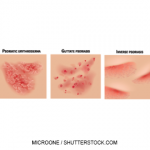More recently, serotonin and endogenous opioids have also been implicated in renal pruritus.20 Based on these observations, current therapies attempt to target a variety of these underlying processes. In renal pruritus, immunologic treatments include thalidomide, pentoxifylline, doxepin and broadband UVB therapy, which have demonstrated efficacy.21-24 Additionally, selective serotonin reuptake inhibitors (SSRIs), naltrexone and nalfurafine have also been employed to target serotonin and opioid dysregulation.25,26 Gabapentin with dialysis has also been shown to be very effective in multiple studies.27,28 However, universal treatments for renal pruritus remain limited.
Itch is a key determinant of the efficacy of new biologic therapeutics in psoriasis.
Another common systemic cause of chronic pruritus is liver disease. Specifically, diseases resulting in cholestasis are the most common cause of chronic itch in this context.29,30 For example, over 69% of patients with primary biliary cirrhosis report pruritus as a symptom.31 Cholestasis-associated pruritus is widespread and intractable, and can be severe enough to warrant liver transplantation.32 Although the pruritogens are unknown, bile salt and their metabolites are believed to be involved. One hypothesis is that pruritogens secreted into bile are converted in the liver and gut to modulate endogenous serotoninergic and opioidergic systems linked to pruritus.33 Treatment of cholestatic pruritus starts with addressing the etiology of liver disease, including gallstone removal or treatment with cholestyramine, which binds bile salts, or rifampin, which inhibits bile acid production.34,35 Additionally, naltrexone, which targets the opioidergic system, has demonstrated some efficacy.36 More recently, the potent neuronal activator lysophosphatidic acid (LPA) has been found to be elevated in sera of patients with cholestasis and pruritus and represents a potential future drug target.37 Similar to renal pruritus, the mechanisms of cholestatic pruritus and other hepatic etiologies still require further investigation for the development of definitive, targeted treatments.
Importantly, independent of end-organ dysfunction causing systemic chronic pruritus, medications should always be considered potential culprits. It is widely appreciated that opioids, calcium channel blockers (CCBs), β-adrenergic blockers and NSAIDs can induce pruritus.38 Hydroxychloroquine, an antimalarial that is often employed in the treatment of rheumatologic diseases, has also been reported to cause pruritus. As highlighted earlier, recent studies by Liu et al have revealed that this is mediated specifically via activation of Mrgpr on itch sensory neurons.11 Therefore, it’s imperative that patients be evaluated for long-term use of medications that may induce their chronic pruritus. Although we review only a few contributors to systemic pruritus, many etiologies exist. Therefore, when working up chronic pruritus, these should should be considered and have been reviewed extensively elsewhere.15,39,40

